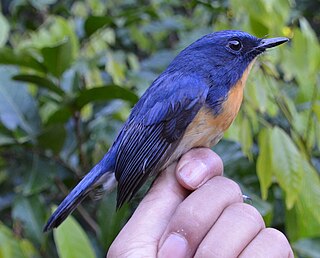
The Old World flycatchers are a large family, the Muscicapidae, of small passerine birds restricted to the Old World, with the exception of several vagrants and two species, bluethroat and northern wheatear, found also in North America. These are mainly small arboreal insectivores, many of which, as the name implies, take their prey on the wing. The family is relatively large and includes 351 species, which are divided into 54 genera.

The Siberian blue robin is a small passerine bird that was formerly classified as a member of the thrush family, Turdidae, but is now more generally considered to belong to the Old World flycatcher family, Muscicapidae. It and similar small European species are often called chats. Recent research suggests that this species and some other East Asian members of Luscinia should be classified in a new genus, together with the Japanese and Ryūkyū robins. The genus name Larvivora comes from the Neo-Latin larva meaning caterpillar and -vorus meaning eating, and cyane is Latin for "dark-blue".

The Indian blue robin is a small bird found in the Indian Subcontinent. Formerly considered a thrush, it is now considered one of the Old World flycatchers in the family Muscicapidae. It was earlier also called the Indian blue chat. It is migratory, breeding in the forests along the Himalayas of Nepal, India, Myanmar and Bangladesh. They winter in the hill forests of the Western Ghats of India and in Sri Lanka.

Brachypteryx is a genus of passerine birds in the family Muscicapidae containing ten species known as shortwings, that occurs in southeast Asia.

Melaenornis is a genus of small passerine birds in the large family Muscicapidae commonly known as the Old World flycatchers. They are restricted to sub-Saharan Africa.

The white-necklaced partridge, also known as the collared partridge or Rickett's hill-partridge, is a species of bird in the family Phasianidae. It is endemic to southeastern China. It is threatened by habitat loss and hunting, and the IUCN has assessed it as near-threatened.

The dark-sided flycatcher is a small passerine bird belonging to the genus Muscicapa in the Old World flycatcher family Muscicapidae. It has a wide breeding distribution in the East Palearctic with northern birds migrating south for the winter. It is also known as the Siberian flycatcher or sooty flycatcher, the latter name is also used for the sooty flycatcher of Africa.

The red-capped robin-chat or Natal robin is a species of passerine bird belonging to the family Muscicapidae. This species is found in Southern and Eastern Africa.

Cyornis is a genus of birds in the Old World flycatcher family Muscicapidae most of which are native to Southeast Asia.

The bearded scrub robin, also known as the eastern bearded scrub robin, is a species of bird in the family Muscicapidae. It is found in eastern and southern Africa.

The large niltava is a species of bird in the Old world flycatcher family Muscicapidae. It is found in Bangladesh, Bhutan, Cambodia, China, India, Indonesia, Laos, Malaysia, Myanmar, Nepal, Thailand and Vietnam. Its natural habitat is subtropical or tropical montane forests.

The rufous-bellied niltava is a species of bird in the family Muscicapidae.

The Taiwanvivid niltava or small vivid niltava is a bird in the family Muscicapidae. The species was first described by Robert Swinhoe in 1864. It is endemic to Taiwan. The Chinese vivid niltava of the Asian mainland, which is larger in size, was formerly considered conspecific. Its natural habitat is subtropical or tropical moist montane forests.

Tarsiger is a genus of six species of birds in the family Muscicapidae. They are small, mostly brightly coloured insectivorous birds native to Asia and northeastern Europe; four of the six species are confined to the Sino-Himalayan mountain system. The genus has sometimes been included within the related genus Luscinia, but the species have been found to form a distinct monophyletic group.

Yuhina is a genus of birds in the white-eye family Zosteropidae.

Bates's paradise flycatcher is a passerine bird belonging to the monarch-flycatcher family, Monarchidae. The sexes are similar in appearance with the upper parts being rufous and the head and underparts being bluish-grey. It is native to central Africa where it is found in the understorey of forests.

The large blue flycatcher is a medium-sized bird species characterized by distinctive sexual dimorphism along with most others of the Flycatcher family. This species of bird is in the family Muscicapidae. It is found in the eastern Himalayas, from Nepal to Bangladesh. It winters in the northern Malay Peninsula.

The white-crowned cliff chat is a species of chat in the family Muscicapidae which occurs in rocky habitats in much of western Sub-Saharan Africa.

Larvivora is a genus of small passerine birds belonging to the Old World flycatcher family Muscicapidae that occur in central and eastern Asia.

The Meratus blue flycatcher is a species of bird in the Old World flycatcher family, Muscicapidae. The species was described in 2021 by the Indonesian ornithologist Mohammed Irham and his colleagues, based on genetic, morphological, and vocal differences with other Cyornis flycatchers. It is endemic to the Meratus Mountains of Indonesian Borneo, where it has been recorded only from Mount Besar. It is most common at elevations between 900 and 1,300 m and inhabits montane rainforest, secondary forest, and rubber plantations. It is sexually dimorphic like other species in its genus; males have blue upperparts, iridescent blue patches on the forehead and shoulders, and orange-and-white underparts, while females have gray-brown heads and upperparts. They have a length of 15.7–16.0 cm (6.2–6.3 in); males weigh 18.5–19.75 g (0.653–0.697 oz) and females weigh 15.75–20.0 g (0.556–0.705 oz).




















